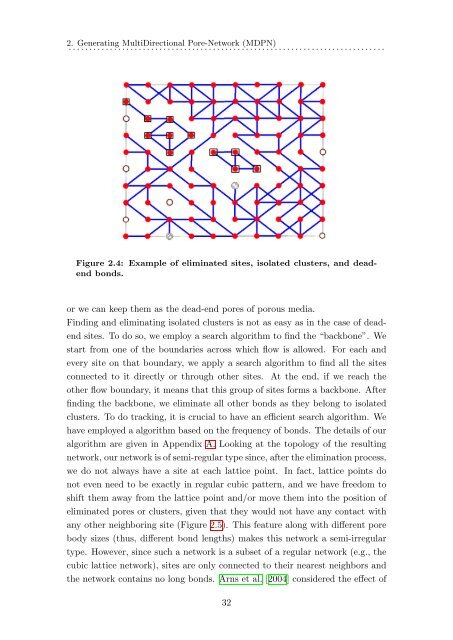download pdf version of PhD book - Universiteit Utrecht
download pdf version of PhD book - Universiteit Utrecht
download pdf version of PhD book - Universiteit Utrecht
You also want an ePaper? Increase the reach of your titles
YUMPU automatically turns print PDFs into web optimized ePapers that Google loves.
2. Generating MultiDirectional Pore-Network (MDPN)<br />
. . . . . . . . . . . . . . . . . . . . . . . . . . . . . . . . . . . . . . . . . . . . . . . . . . . . . . . . . . . . . . . . . . . . . . . . . . . . .<br />
Figure 2.4: Example <strong>of</strong> eliminated sites, isolated clusters, and deadend<br />
bonds.<br />
or we can keep them as the dead-end pores <strong>of</strong> porous media.<br />
Finding and eliminating isolated clusters is not as easy as in the case <strong>of</strong> deadend<br />
sites. To do so, we employ a search algorithm to find the “backbone”. We<br />
start from one <strong>of</strong> the boundaries across which flow is allowed. For each and<br />
every site on that boundary, we apply a search algorithm to find all the sites<br />
connected to it directly or through other sites. At the end, if we reach the<br />
other flow boundary, it means that this group <strong>of</strong> sites forms a backbone. After<br />
finding the backbone, we eliminate all other bonds as they belong to isolated<br />
clusters. To do tracking, it is crucial to have an efficient search algorithm. We<br />
have employed a algorithm based on the frequency <strong>of</strong> bonds. The details <strong>of</strong> our<br />
algorithm are given in Appendix A. Looking at the topology <strong>of</strong> the resulting<br />
network, our network is <strong>of</strong> semi-regular type since, after the elimination process,<br />
we do not always have a site at each lattice point. In fact, lattice points do<br />
not even need to be exactly in regular cubic pattern, and we have freedom to<br />
shift them away from the lattice point and/or move them into the position <strong>of</strong><br />
eliminated pores or clusters, given that they would not have any contact with<br />
any other neighboring site (Figure 2.5). This feature along with different pore<br />
body sizes (thus, different bond lengths) makes this network a semi-irregular<br />
type. However, since such a network is a subset <strong>of</strong> a regular network (e.g., the<br />
cubic lattice network), sites are only connected to their nearest neighbors and<br />
the network contains no long bonds. Arns et al. [2004] considered the effect <strong>of</strong><br />
32

















